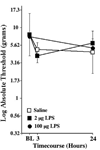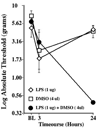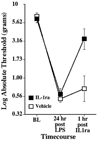Evidence for a role of heat shock protein-90 in toll like receptor 4 mediated pain enhancement in rats
- PMID: 19788917
- PMCID: PMC2783248
- DOI: 10.1016/j.neuroscience.2009.09.046
Evidence for a role of heat shock protein-90 in toll like receptor 4 mediated pain enhancement in rats
Abstract
Spinal cord microglial toll-like receptor 4 (TLR4) has been implicated in enhancing neuropathic pain and opposing morphine analgesia. The present study was initiated to explore TLR4-mediated pain modulation by intrathecal lipopolysaccharide, a classic TLR4 agonist. However, our initial study revealed that intrathecal lipopolysaccharide failed to induce low-threshold mechanical allodynia in naive rats, suggestive that TLR4 agonism may be insufficient to enhance pain. These studies explore the possibility that a second signal is required; namely, heat shock protein-90 (HSP90). This candidate was chosen for study given its known importance as a regulator of TLR4 signaling. A combination of in vitro TLR4 cell signaling and in vivo behavioral studies of pain modulation suggest that TLR4-enhancement of neuropathic pain and TLR4-suppression of morphine analgesia each likely require HSP90 as a cofactor for the effects observed. In vitro studies revealed that dimethyl sulfoxide (DMSO) enhances HSP90 release, suggestive that this may be a means by which DMSO enhances TLR4 signaling. While 2 and 100 microg lipopolysaccharide intrathecally did not induce mechanical allodynia across the time course tested, co-administration of 1 microg lipopolysaccharide with a drug that enhances HSP90-mediated TLR4 signaling now induced robust allodynia. In support of this allodynia being mediated via a TLR4/HSP90 pathway, it was prevented or reversed by intrathecal co-administration of a HSP90 inhibitor, a TLR4 inhibitor, a microglia/monocyte activation inhibitor (as monocyte-derived cells are the predominant cell type expressing TLR4), and interleukin-1 receptor antagonist (as this proinflammatory cytokine is a downstream consequence of TLR4 activation). Together, these results suggest for the first time that TLR4 activation is necessary but not sufficient to induce spinally mediated pain enhancement. Rather, the data suggest that TLR4-dependent pain phenomena may require contributions by multiple components of the TLR4 receptor complex.
Figures








Similar articles
-
Evidence that intrathecal morphine-3-glucuronide may cause pain enhancement via toll-like receptor 4/MD-2 and interleukin-1beta.Neuroscience. 2010 Jan 20;165(2):569-83. doi: 10.1016/j.neuroscience.2009.10.011. Neuroscience. 2010. PMID: 19833175 Free PMC article.
-
[Spinal cord Toll like receptor 4 and its co-stimulatory molecule heat shock protein 90 may parti-cipate in electroacupuncture analgesia in rats with chronic neuropathic pain].Zhen Ci Yan Jiu. 2021 Sep 25;46(9):735-41. doi: 10.13702/j.1000-0607.201103. Zhen Ci Yan Jiu. 2021. PMID: 34558238 Chinese.
-
Proinflammatory cytokines oppose opioid-induced acute and chronic analgesia.Brain Behav Immun. 2008 Nov;22(8):1178-89. doi: 10.1016/j.bbi.2008.05.004. Epub 2008 Jul 2. Brain Behav Immun. 2008. PMID: 18599265 Free PMC article.
-
Toll-Like Receptor 4 (TLR4)/Opioid Receptor Pathway Crosstalk and Impact on Opioid Analgesia, Immune Function, and Gastrointestinal Motility.Front Immunol. 2020 Jul 8;11:1455. doi: 10.3389/fimmu.2020.01455. eCollection 2020. Front Immunol. 2020. PMID: 32733481 Free PMC article. Review.
-
The role of heat shock protein 90 in regulating pain, opioid signaling, and opioid antinociception.Vitam Horm. 2019;111:91-103. doi: 10.1016/bs.vh.2019.05.010. Epub 2019 Jul 15. Vitam Horm. 2019. PMID: 31421708 Review.
Cited by
-
Select steroid hormone glucuronide metabolites can cause toll-like receptor 4 activation and enhanced pain.Brain Behav Immun. 2015 Feb;44:128-36. doi: 10.1016/j.bbi.2014.09.004. Epub 2014 Sep 16. Brain Behav Immun. 2015. PMID: 25218902 Free PMC article.
-
Heat-shock protein 90 (Hsp90) promotes opioid-induced anti-nociception by an ERK mitogen-activated protein kinase (MAPK) mechanism in mouse brain.J Biol Chem. 2017 Jun 23;292(25):10414-10428. doi: 10.1074/jbc.M116.769489. Epub 2017 Apr 27. J Biol Chem. 2017. PMID: 28450396 Free PMC article.
-
Robust spinal neuroinflammation mediates mechanical allodynia in Walker 256 induced bone cancer rats.Mol Brain. 2012 May 20;5:16. doi: 10.1186/1756-6606-5-16. Mol Brain. 2012. PMID: 22607655 Free PMC article.
-
Protraction of neuropathic pain by morphine is mediated by spinal damage associated molecular patterns (DAMPs) in male rats.Brain Behav Immun. 2018 Aug;72:45-50. doi: 10.1016/j.bbi.2017.08.018. Epub 2017 Aug 30. Brain Behav Immun. 2018. PMID: 28860068 Free PMC article.
-
The impact of a heat therapy intervention on pain and fibromyalgia symptoms in patients with fibromyalgia: a pilot study.Front Pain Res (Lausanne). 2025 Mar 13;6:1526491. doi: 10.3389/fpain.2025.1526491. eCollection 2025. Front Pain Res (Lausanne). 2025. PMID: 40182803 Free PMC article.
References
-
- Akashi-Takamura S, Miyake K. TLR accessory molecules. Curr Opin Immunol. 2008;20:420–425. - PubMed
-
- Basu S, Binder RJ, Ramalingam T, Srivastava PK. CD91 is a common receptor for heat shock proteins gp96, hsp90, hsp70, and calreticulin. Immunity. 2001;14:303–313. - PubMed
-
- Beg AA. Endogenous ligands of Toll-like receptors: implications for regulating inflammatory and immune responses. Trends Immunol. 2002;23:509–512. - PubMed
-
- Bennett GJ, Xie YK. A peripheral mononeuropathy in rat that produces disorders of pain sensation like those seen in man. Pain. 1988;33:87–107. - PubMed
Publication types
MeSH terms
Substances
Grants and funding
LinkOut - more resources
Full Text Sources
Other Literature Sources
Medical

